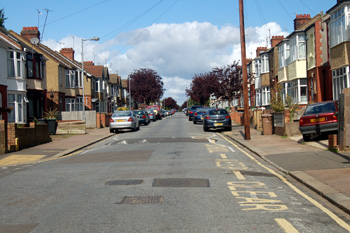Luton Population History

Argyll Avenue September 2009
Luton is easily the largest settlement in the county but it was not always so. In the 1840s it finally overhauled Bedford as the largest town and the impact of the railways quickly made it the large, urban settlement it is today. The census figures below are for the civil parish until 1891 and then for the borough.
- 1801: 3,095 (Bedford, by contrast, 3,948);
- 1811: 3,716 (Bedford, by contrast, 4,605);
- 1821: 4,529 (2,986 in the town itself; Bedford, by contrast, 5,466);
- 1831: 5,693 (3,961 in the town itself; Bedford, by contrast, 6,959);
- 1841: 7,748 (5,827 in the town itself; Bedford, by contrast, 9,178);
- 1851: 12,787 (10,648 in the town itself; Bedford, by contrast, 11,693);
- 1861: 17,821 (15.329 in the town itself);
- 1871: 20,733 (17,317 in the town itself);
- 1881: 26,140 (23,960 in the town itself);
- 1891: 32,401 (30,053 in the town itself);
- 1901: 36,404 (Leagrave, Limbury, and Stopsley, separate civil parishes, respectively 801, 377 and 787);
- 1911: 49,978 (Leagrave, Limbury, and Stopsley, separate civil parishes, respectively 1,270, 972 and 943);
- 1921: 57,075 (Leagrave, Limbury, and Stopsley, separate civil parishes, respectively 1,643, 1,534 and 1,140);
- 1931: 68,523 (Stopsley, a separate civil parish, 1,474);
- 1951: 110,381;
- 1961: 131,583;
- 1971: 161,405;
- 1981: 164,049;
- 1991: 167,009;
- 2001: 184,371.